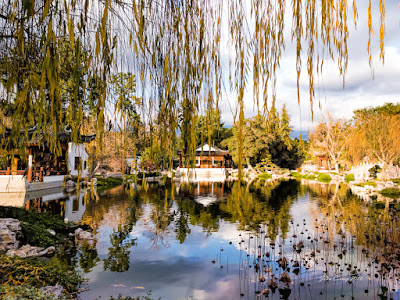 |
| A photograph of the Chinese Gardens at the Huntington Library in San Marino, California that was developed from a DNG file taken with a Google Pixel XL smartphone |
Film photographers expose their photograph onto a light-sensitive filmstrip or plate and then develop that into a negative. Using various processes and adjustments, the negative can then be printed multiple times and in different ways, resulting in a variety of photographic prints.
In the realm of digital photography, the RAW file is the equivalent of the image stored on the film. Just like with a film negative, from the one RAW file, many different images can be rendered in the "post-processing" of the "digital darkroom". No matter how many different treatments the original negative (RAW file) is given, the RAW file is always available intact in its original state from which you can start from scratch again.
The other option in the modern digital photography world is to take your photos in jpeg format. The jpeg file can be compared to a developed print in the world of film photography. When you take a photo in jpeg format, your camera makes its own judgements about how the final print should look using what's known as an "algorithm" executed by the software in your camera or mobile phone. Essentially the software acts as developer and post-processor and comes up with a "print" for you. The "negative" of the original image with all its "raw" information is not retained.
The jpeg file is also compressed, meaning after the algorithm is executed and the "print" file is finalized, some of the data is discarded in the interests of creating a smaller file. This technology was developed in the early days of computing and the internet, when smaller files were preferred because of the cost of storage and the narrow bandwidth of the internet in the days of internet "dial-up modems".
So the advantages of a RAW file over a jpeg file are:
- The file is not compressed; none of the information necessary to create the image from the RAW file is discarded. In fact, the RAW file is not really an image at all, but a file containing all of the information necessary to generate an image.
- Secondly, the metadata of the RAW file can be adjusted in "the digital darkroom" in a non-destructive manner, which means that at any time, you can go back and 'reset' any adjustments you have made and return to the original RAW file.
- The final judgements of how the image and print file should be rendered are left to the photographer, and not to a software algorithm.
Each camera maker has their own proprietary RAW file format. For example, Canon's RAW format files use CRW as the file extension. Nikon uses NEF. To be able to read the file and render it as an image you need to use software that has a converter or plug-in that can read and render the RAW file. The most-widely known examples of such software are Adobe Photoshop and Adobe Lightroom.
However, the trend is now to use a common RAW file format that has long been advocated by Adobe, known as the "digital negative" RAW file format. Such files use DNG as their file extension. This is an "open source" format. Recently, Google adopted DNG as its standard for RAW format files for devices using the Android operating system, a move that should give considerable impetus to the adoption of this common format by all camera makers.
Hopefully I have been able to answer your question as to what RAW format photography is all about. In my next post I will tell you how you can take DNG photos using an Android phone and also how to process the file with some apps for Android phones. See you then!
John Corney







No comments:
Post a Comment